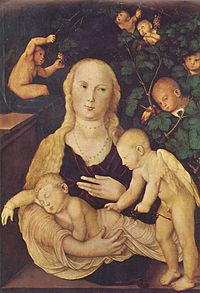Women's Refuge Museum
The women's shelter museum ( French Musée de l'Œuvre Notre-Dame ) is the museum of the building works of the Strasbourg cathedral and generally the museum of the city of Strasbourg for arts and crafts in the Rhenish region from the Middle Ages to 1681. The museum is famous for its rich collection of sculptures , Glass windows, architectural fragments and building plans of the cathedral as well as for its considerable collection of works by Peter Hemmel von Andlaus , Niclas Gerhaert van Leydens , Niklaus von Hagenaus , Ivo Strigels , Konrad Witzens , Hans Baldungs , Hans Wydyz and Sebastian Stoskopffs .
historical overview
The Strasbourg cathedral builder ( Fondation de l'Œuvre Notre-Dame ) was first mentioned in 1281 and is still responsible for the maintenance of the cathedral. In addition to the construction plans that have been kept since the beginning, it preserves components such as fragments of the rood screen that was destroyed in 1681 and the originals of the sculptures that were removed or knocked down during the French Revolution and later replaced by copies. The Société pour la conservation des monuments historiques d'Alsace (Society for the Conservation of the Historic Monuments of Alsace), founded in 1855, endeavored for its part to save the most valuable components and decorations (altars, statues, vessels, tapestries) from destruction or decay of churches , Monasteries and chapels throughout Alsace. The city's collection of paintings, restored by Wilhelm von Bode from 1890 onwards , was in turn focused on regional masters right from the start with the donation of the "Portrait of Canon Ambrosius Volmar Keller ", a masterpiece by Hans Baldung from Wilhelm II's private collection . In the new arts and crafts museum of the city, the “Hohenlohe Museum”, works of applied arts from the Middle Ages, Renaissance and early Baroque were exhibited. These four collections, which were kept in different locations and focused on various focal points, were combined in the newly founded Women's Refuge Museum in 1931. In 1956, after the war damage caused by the bombing of Strasbourg in 1944, the building was reopened in an enlarged state.
In addition to the cathedral sculptures, glass windows, etc., the collection also includes valuable components from other Strasbourg churches, such as the Dominican Church, which was destroyed in 1870 , the Old Saint Peter Church , which was rebuilt from 1867, and the Magdalen Church , which burned down in 1904 . The Romanesque components (cloister, baptismal font) from Eschau and the stained glass windows from Wissembourg (including the “ Weißenburger Christ Head ”) and Mutzig are also important . Numerous late Gothic altars can also be assigned to anonymous masters from the Schongau School .
literature
General
- Cécile Dupeux: Strasbourg, Musée de l'Œuvre Notre-Dame , Éditions Scala, Paris, 1999, ISBN 2-86656-223-2
- Cécile Dupeux (ed.): Musée de l'Œuvre Notre-Dame / Arts du Moyen Âge et de la Renaissance , Éditions des Musées de Strasbourg, Strasbourg, 2013, ISBN 978-2-3512-5105-8
Specific focus of the collection
- Cécile Dupeux: designs. Cathédrale de Strasbourg , Éditions des Musées de Strasbourg, Strasbourg, 2015, ISBN 978-2-3512-5115-7 (Medieval blueprints of the Strasbourg cathedral)
- Cécile Dupeux and Barbara Gatineau: D'argent, de nacre et d'os. Objets d'art et de curiosité , Éditions des Musées de Strasbourg, Strasbourg, 2015, ISBN 978-2-3512-5132-4 (applied arts 11th to 17th centuries)
Web links
Coordinates: 48 ° 34 ′ 51 ″ N , 7 ° 45 ′ 5 ″ E


